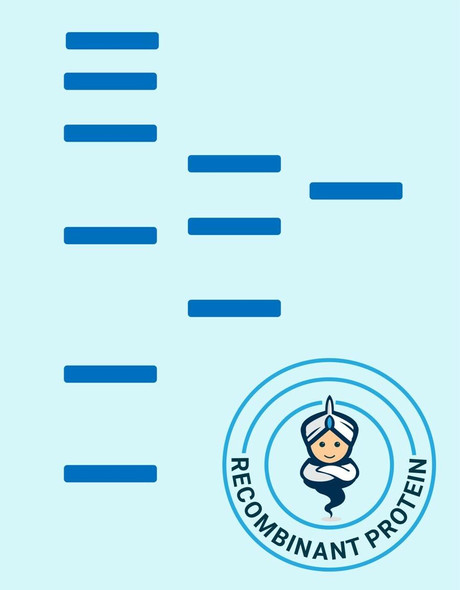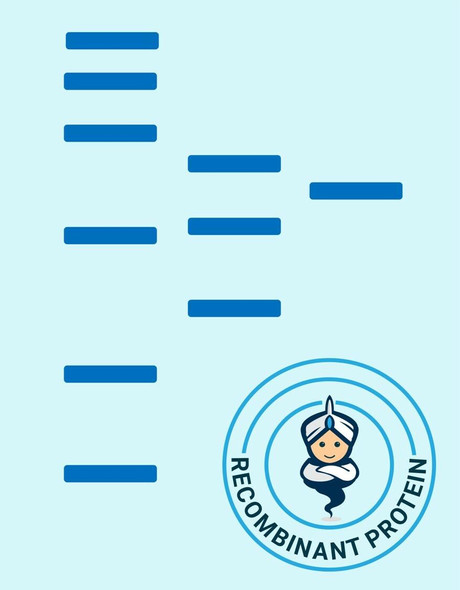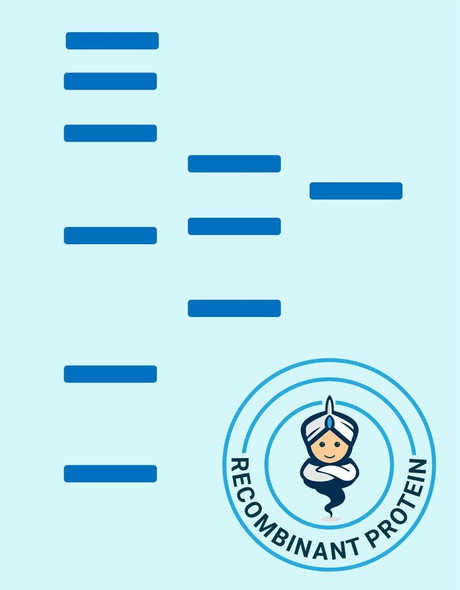Human APTX Recombinant Protein (RPPB2769)
- SKU:
- RPPB2769
- Product type:
- Recombinant Protein
- Size:
- 10ug
- Species:
- Human
- Target:
- APTX
- Synonyms:
- AXA1
- AOA
- FHA-HIT
- AOA11
- Source:
- Escherichia Coli
- Uniprot:
- Q7Z2E3
Description
| Product Name: | Human APTX Recombinant Protein |
| Product Code: | RPPB2769 |
| Size: | 10µg |
| Species: | Human |
| Target: | APTX |
| Synonyms: | AXA1, AOA, FHA-HIT, AOA11, ataxia 1, early onset with hypoalbuminemia1 EOAHA1, EAOH1, Forkhead-associated domain histidine triad-like protein, APTX, Aprataxin, AOA1, EAOH, EOAHA, MGC1072, FLJ20157. |
| Source: | Escherichia Coli |
| Physical Appearance: | Sterile Filtered clear colorless solution. |
| Formulation: | The APTX solution contains 20mM Tris-HCl pH-7.5, 0.1M NaCl, 0.1mM PMSF and 20% glycerol. |
| Stability: | Store at 4°C if entire vial will be used within 2-4 weeks. Store, frozen at -20°C for longer periods of time. For long term storage it is recommended to add a carrier protein (0.1% HSA or BSA).Avoid multiple freeze-thaw cycles. |
| Purity: | Greater than 95.0% as determined by SDS-PAGE. |
| Amino Acid Sequence: | MRGSHHHHHH GMASMTGGQQ MGRDLYDDDD KDRWAGSMQD PKMQVYKDEQ VVVIKDKYPK ARYHWLVLPW TSISSLKAVA REHLELLKHM HTVGEKVIVD FAGSSKLRFR LGYHAIPSMS HVHLHVISQD FDSPCLKNKK HWNSFNTEYF LESQAVIEMV QEAGRVTVRD GMPELLKLPL RCHECQQLLP SIPQLKEHLR KHWTQ |
APTX is a DNA-binding protein which participates in single-strand DNA break repair, double-strand DNA break repair and base excision repair. APTX determines abortive DNA ligation intermediates created each at base excision sites, or while DNA ligases attempt to restore non-ligatable breaks induced by reactive oxygen species. APTX catalyzes the release of adenylate groups covalently linked to 5''-phosphate termini, resulting in the production of 5''-phosphate termini that can be efficiently rejoined. APTX hydrolyzes adenosine 5''-monophosphoramidate (AMP-NH(2)) and diadenosine tetraphosphate (AppppA), but with lower catalytic activity.
APTX Human Recombinant fused to a 37 amino acid His Tag at N-terminal produced in E.Coli is a single, non-glycosylated, polypeptide chain containing 205 amino acids (1-168 a.a) and having a molecular mass of 23.9 kDa. The APTX is purified by proprietary chromatographic techniques.
| UniProt Protein Function: | APTX: DNA-binding protein involved in single-strand DNA break repair, double-strand DNA break repair and base excision repair. Resolves abortive DNA ligation intermediates formed either at base excision sites, or when DNA ligases attempt to repair non- ligatable breaks induced by reactive oxygen species. Catalyzes the release of adenylate groups covalently linked to 5'-phosphate termini, resulting in the production of 5'-phosphate termini that can be efficiently rejoined. Also able to hydrolyze adenosine 5'- monophosphoramidate (AMP-NH(2)) and diadenosine tetraphosphate (AppppA), but with lower catalytic activity. Defects in APTX are the cause of ataxia-oculomotor apraxia syndrome (AOA). AOA is an autosomal recessive syndrome characterized by early-onset cerebellar ataxia, oculomotor apraxia, early areflexia and late peripheral neuropathy. 13 isoforms of the human protein are produced by alternative splicing. |
| UniProt Protein Details: | Protein type:Nucleolus; EC 3.-.-.-; C2H2-type zinc finger protein; RNA-binding; Phosphatase (non-protein); DNA repair, damage Chromosomal Location of Human Ortholog: 9p13.3 Cellular Component: nucleoplasm; nuclear chromatin; cytoplasm; nucleolus; chromatin; nucleus Molecular Function:protein binding; DNA 5'-adenosine monophosphate hydrolase activity; phosphoglycolate phosphatase activity; polynucleotide 3'-phosphatase activity; metal ion binding; double-stranded DNA binding; double-stranded RNA binding; damaged DNA binding; phosphoprotein binding; protein N-terminus binding; chromatin binding Biological Process: single strand break repair; response to hydrogen peroxide; dephosphorylation; double-strand break repair; regulation of protein stability; DNA catabolic process, exonucleolytic; response to DNA damage stimulus; DNA ligation Disease: Ataxia, Early-onset, With Oculomotor Apraxia And Hypoalbuminemia |
| NCBI Summary: | This gene encodes a member of the histidine triad (HIT) superfamily. The encoded protein may play a role in single-stranded DNA repair through its nucleotide-binding activity and its diadenosine polyphosphate hydrolase activity. Mutations in this gene have been associated with ataxia-ocular apraxia. Alternatively spliced transcript variants have been identified for this gene.[provided by RefSeq, Aug 2010] |
| UniProt Code: | Q7Z2E3 |
| NCBI GenInfo Identifier: | 48428038 |
| NCBI Gene ID: | 54840 |
| NCBI Accession: | Q7Z2E3.2 |
| UniProt Secondary Accession: | Q7Z2E3,Q0P662, Q5T781, Q5T782, Q5T784, Q6JV81, Q6JV82 Q6JV85, Q7Z2F3, A8MTN4, D3DRK9, D3DRL0, |
| UniProt Related Accession: | Q7Z2E3 |
| Molecular Weight: | |
| NCBI Full Name: | Aprataxin |
| NCBI Synonym Full Names: | aprataxin |
| NCBI Official Symbol: | APTX |
| NCBI Official Synonym Symbols: | AOA; AOA1; AXA1; EAOH; EOAHA; FHA-HIT |
| NCBI Protein Information: | aprataxin; forkhead-associated domain histidine triad-like protein |
| UniProt Protein Name: | Aprataxin |
| UniProt Synonym Protein Names: | Forkhead-associated domain histidine triad-like protein; FHA-HIT |
| Protein Family: | Aprataxin |
| UniProt Gene Name: | APTX |
| UniProt Entry Name: | APTX_HUMAN |










